2007 INFINITI QX56 ABS
[x] Cancel search: ABSPage 2871 of 3061
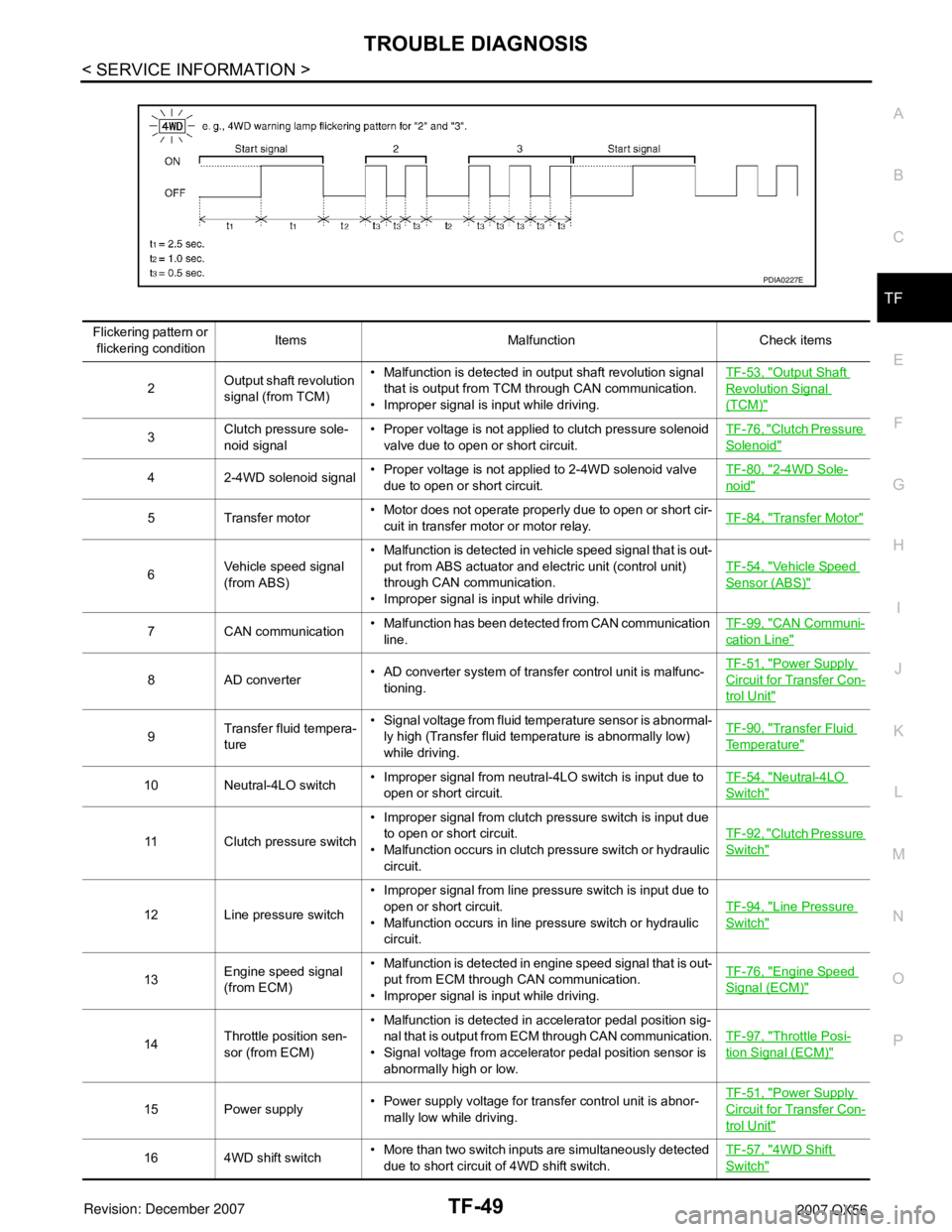
TROUBLE DIAGNOSIS
TF-49
< SERVICE INFORMATION >
C
E
F
G
H
I
J
K
L
MA
B
TF
N
O
P
PDIA0227E
Flickering pattern or
flickering conditionItems Malfunction Check items
2Output shaft revolution
signal (from TCM)• Malfunction is detected in output shaft revolution signal
that is output from TCM through CAN communication.
• Improper signal is input while driving.TF-53, "
Output Shaft
Revolution Signal
(TCM)"
3Clutch pressure sole-
noid signal• Proper voltage is not applied to clutch pressure solenoid
valve due to open or short circuit.TF-76, "Clutch Pressure
Solenoid"
4 2-4WD solenoid signal• Proper voltage is not applied to 2-4WD solenoid valve
due to open or short circuit.TF-80, "2-4WD Sole-
noid"
5 Transfer motor• Motor does not operate properly due to open or short cir-
cuit in transfer motor or motor relay.TF-84, "Transfer Motor"
6Vehicle speed signal
(from ABS)• Malfunction is detected in vehicle speed signal that is out-
put from ABS actuator and electric unit (control unit)
through CAN communication.
• Improper signal is input while driving.TF-54, "Vehicle Speed
Sensor (ABS)"
7 CAN communication• Malfunction has been detected from CAN communication
line.TF-99, "CAN Communi-
cation Line"
8 AD converter• AD converter system of transfer control unit is malfunc-
tioning.TF-51, "
Power Supply
Circuit for Transfer Con-
trol Unit"
9Transfer fluid tempera-
ture• Signal voltage from fluid temperature sensor is abnormal-
ly high (Transfer fluid temperature is abnormally low)
while driving.TF-90, "Transfer Fluid
Temperature"
10 Neutral-4LO switch• Improper signal from neutral-4LO switch is input due to
open or short circuit.TF-54, "Neutral-4LO
Switch"
11 Clutch pressure switch• Improper signal from clutch pressure switch is input due
to open or short circuit.
• Malfunction occurs in clutch pressure switch or hydraulic
circuit.TF-92, "Clutch Pressure
Switch"
12 Line pressure switch• Improper signal from line pressure switch is input due to
open or short circuit.
• Malfunction occurs in line pressure switch or hydraulic
circuit.TF-94, "Line Pressure
Switch"
13Engine speed signal
(from ECM)• Malfunction is detected in engine speed signal that is out-
put from ECM through CAN communication.
• Improper signal is input while driving.TF-76, "Engine Speed
Signal (ECM)"
14Throttle position sen-
sor (from ECM)• Malfunction is detected in accelerator pedal position sig-
nal that is output from ECM through CAN communication.
• Signal voltage from accelerator pedal position sensor is
abnormally high or low.TF-97, "Throttle Posi-
tion Signal (ECM)"
15 Power supply• Power supply voltage for transfer control unit is abnor-
mally low while driving.TF-51, "
Power Supply
Circuit for Transfer Con-
trol Unit"
16 4WD shift switch• More than two switch inputs are simultaneously detected
due to short circuit of 4WD shift switch.TF-57, "4WD Shift
Switch"
Page 2872 of 3061
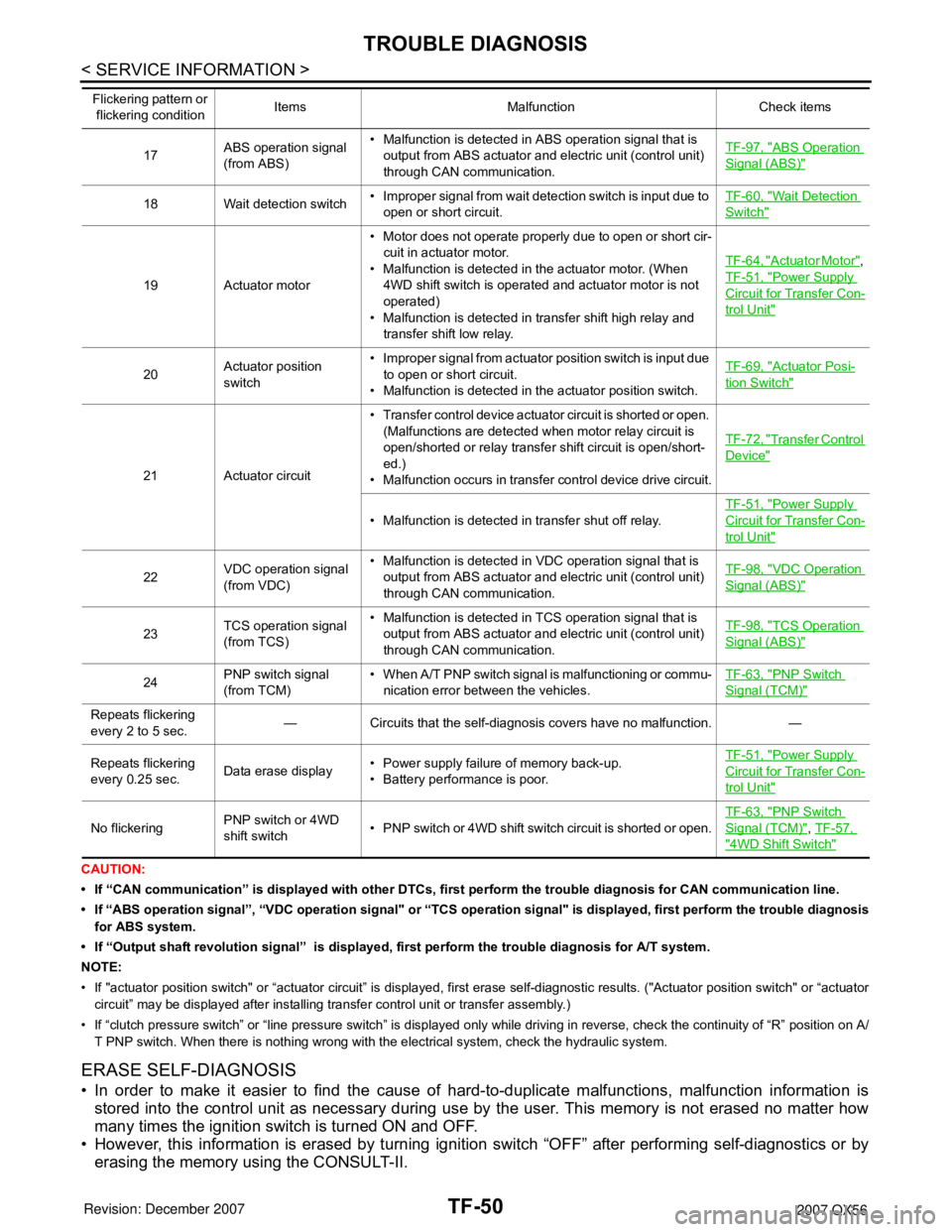
TF-50
< SERVICE INFORMATION >
TROUBLE DIAGNOSIS
CAUTION:
• If “CAN communication” is displayed with other DTCs, first perform the trouble diagnosis for CAN communication line.
• If “ABS operation signal”, “VDC operation signal" or “TCS operation signal" is displayed, first perform the trouble diagnosis
for ABS system.
• If “Output shaft revolution signal” is displayed, first perform the trouble diagnosis for A/T system.
NOTE:
• If "actuator position switch" or “actuator circuit” is displayed, first erase self-diagnostic results. ("Actuator position switch" or “actuator
circuit” may be displayed after installing transfer control unit or transfer assembly.)
• If “clutch pressure switch” or “line pressure switch” is displayed only while driving in reverse, check the continuity of “R” position on A/
T PNP switch. When there is nothing wrong with the electrical system, check the hydraulic system.
ERASE SELF-DIAGNOSIS
• In order to make it easier to find the cause of hard-to-duplicate malfunctions, malfunction information is
stored into the control unit as necessary during use by the user. This memory is not erased no matter how
many times the ignition switch is turned ON and OFF.
• However, this information is erased by turning ignition switch “OFF” after performing self-diagnostics or by
erasing the memory using the CONSULT-II.
17ABS operation signal
(from ABS)• Malfunction is detected in ABS operation signal that is
output from ABS actuator and electric unit (control unit)
through CAN communication.TF-97, "ABS Operation
Signal (ABS)"
18 Wait detection switch• Improper signal from wait detection switch is input due to
open or short circuit.TF-60, "Wait Detection
Switch"
19 Actuator motor• Motor does not operate properly due to open or short cir-
cuit in actuator motor.
• Malfunction is detected in the actuator motor. (When
4WD shift switch is operated and actuator motor is not
operated)
• Malfunction is detected in transfer shift high relay and
transfer shift low relay.TF-64, "
Actuator Motor",
TF-51, "
Power Supply
Circuit for Transfer Con-
trol Unit"
20Actuator position
switch• Improper signal from actuator position switch is input due
to open or short circuit.
• Malfunction is detected in the actuator position switch.TF-69, "Actuator Posi-
tion Switch"
21 Actuator circuit• Transfer control device actuator circuit is shorted or open.
(Malfunctions are detected when motor relay circuit is
open/shorted or relay transfer shift circuit is open/short-
ed.)
• Malfunction occurs in transfer control device drive circuit.TF-72, "
Transfer Control
Device"
• Malfunction is detected in transfer shut off relay.TF-51, "
Power Supply
Circuit for Transfer Con-
trol Unit"
22VDC operation signal
(from VDC)• Malfunction is detected in VDC operation signal that is
output from ABS actuator and electric unit (control unit)
through CAN communication.TF-98, "VDC Operation
Signal (ABS)"
23TCS operation signal
(from TCS)• Malfunction is detected in TCS operation signal that is
output from ABS actuator and electric unit (control unit)
through CAN communication.TF-98, "TCS Operation
Signal (ABS)"
24PNP switch signal
(from TCM)• When A/T PNP switch signal is malfunctioning or commu-
nication error between the vehicles.TF-63, "PNP Switch
Signal (TCM)"
Repeats flickering
every 2 to 5 sec.— Circuits that the self-diagnosis covers have no malfunction. —
Repeats flickering
every 0.25 sec.Data erase display• Power supply failure of memory back-up.
• Battery performance is poor.TF-51, "
Power Supply
Circuit for Transfer Con-
trol Unit"
No flickeringPNP switch or 4WD
shift switch• PNP switch or 4WD shift switch circuit is shorted or open.TF-63, "
PNP Switch
Signal (TCM)", TF-57,
"4WD Shift Switch"
Flickering pattern or
flickering conditionItems Malfunction Check items
Page 2876 of 3061
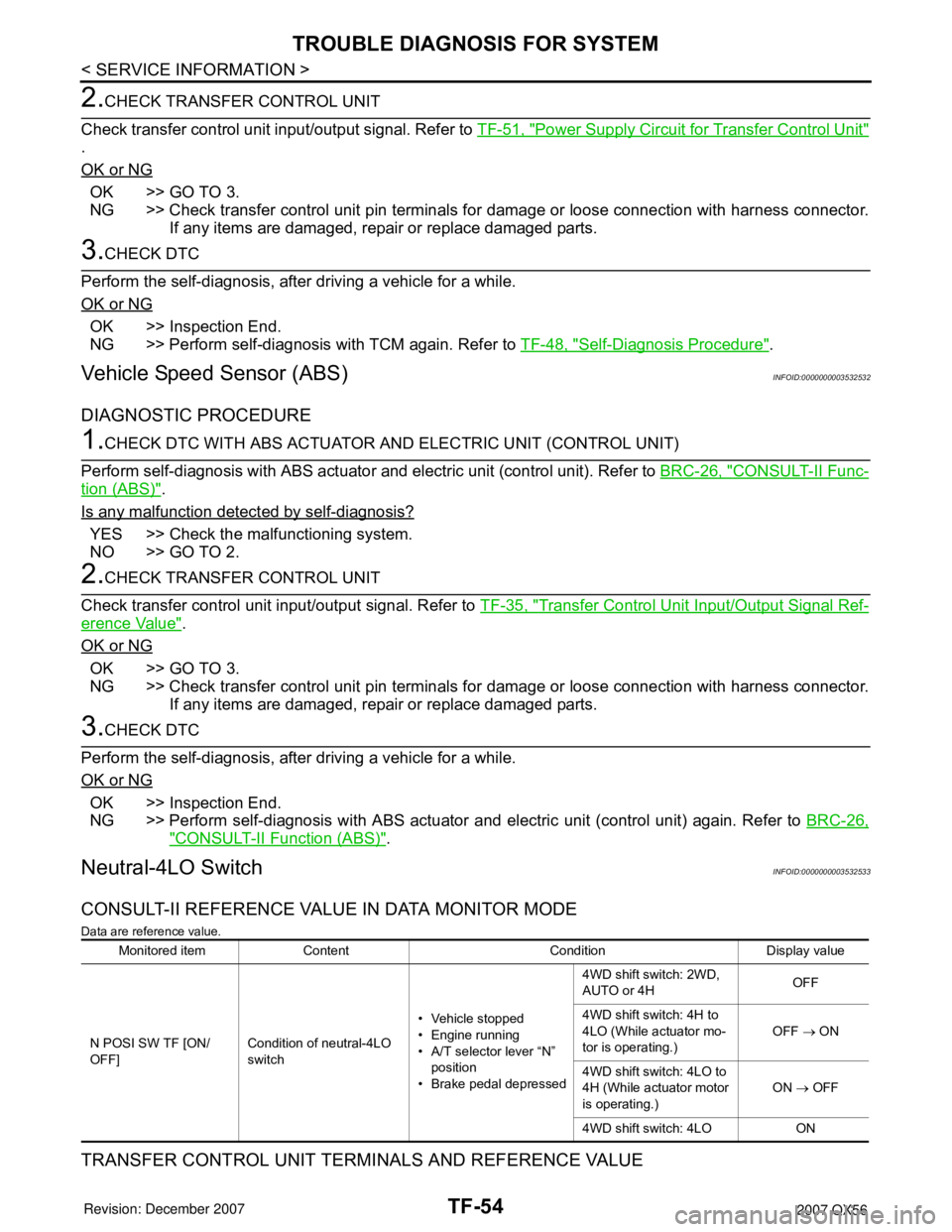
TF-54
< SERVICE INFORMATION >
TROUBLE DIAGNOSIS FOR SYSTEM
2.CHECK TRANSFER CONTROL UNIT
Check transfer control unit input/output signal. Refer to TF-51, "
Power Supply Circuit for Transfer Control Unit"
.
OK or NG
OK >> GO TO 3.
NG >> Check transfer control unit pin terminals for damage or loose connection with harness connector.
If any items are damaged, repair or replace damaged parts.
3.CHECK DTC
Perform the self-diagnosis, after driving a vehicle for a while.
OK or NG
OK >> Inspection End.
NG >> Perform self-diagnosis with TCM again. Refer to TF-48, "
Self-Diagnosis Procedure".
Vehicle Speed Sensor (ABS)INFOID:0000000003532532
DIAGNOSTIC PROCEDURE
1.CHECK DTC WITH ABS ACTUATOR AND ELECTRIC UNIT (CONTROL UNIT)
Perform self-diagnosis with ABS actuator and electric unit (control unit). Refer to BRC-26, "
CONSULT-II Func-
tion (ABS)".
Is any malfunction detected by self-diagnosis?
YES >> Check the malfunctioning system.
NO >> GO TO 2.
2.CHECK TRANSFER CONTROL UNIT
Check transfer control unit input/output signal. Refer to TF-35, "
Transfer Control Unit Input/Output Signal Ref-
erence Value".
OK or NG
OK >> GO TO 3.
NG >> Check transfer control unit pin terminals for damage or loose connection with harness connector.
If any items are damaged, repair or replace damaged parts.
3.CHECK DTC
Perform the self-diagnosis, after driving a vehicle for a while.
OK or NG
OK >> Inspection End.
NG >> Perform self-diagnosis with ABS actuator and electric unit (control unit) again. Refer to BRC-26,
"CONSULT-II Function (ABS)".
Neutral-4LO SwitchINFOID:0000000003532533
CONSULT-II REFERENCE VALUE IN DATA MONITOR MODE
Data are reference value.
TRANSFER CONTROL UNIT TERMINALS AND REFERENCE VALUE
Monitored item Content Condition Display value
N POSI SW TF [ON/
OFF]Condition of neutral-4LO
switch• Vehicle stopped
• Engine running
• A/T selector lever “N”
position
• Brake pedal depressed4WD shift switch: 2WD,
AUTO or 4HOFF
4WD shift switch: 4H to
4LO (While actuator mo-
tor is operating.)OFF → ON
4WD shift switch: 4LO to
4H (While actuator motor
is operating.)ON → OFF
4WD shift switch: 4LO ON
Page 2919 of 3061
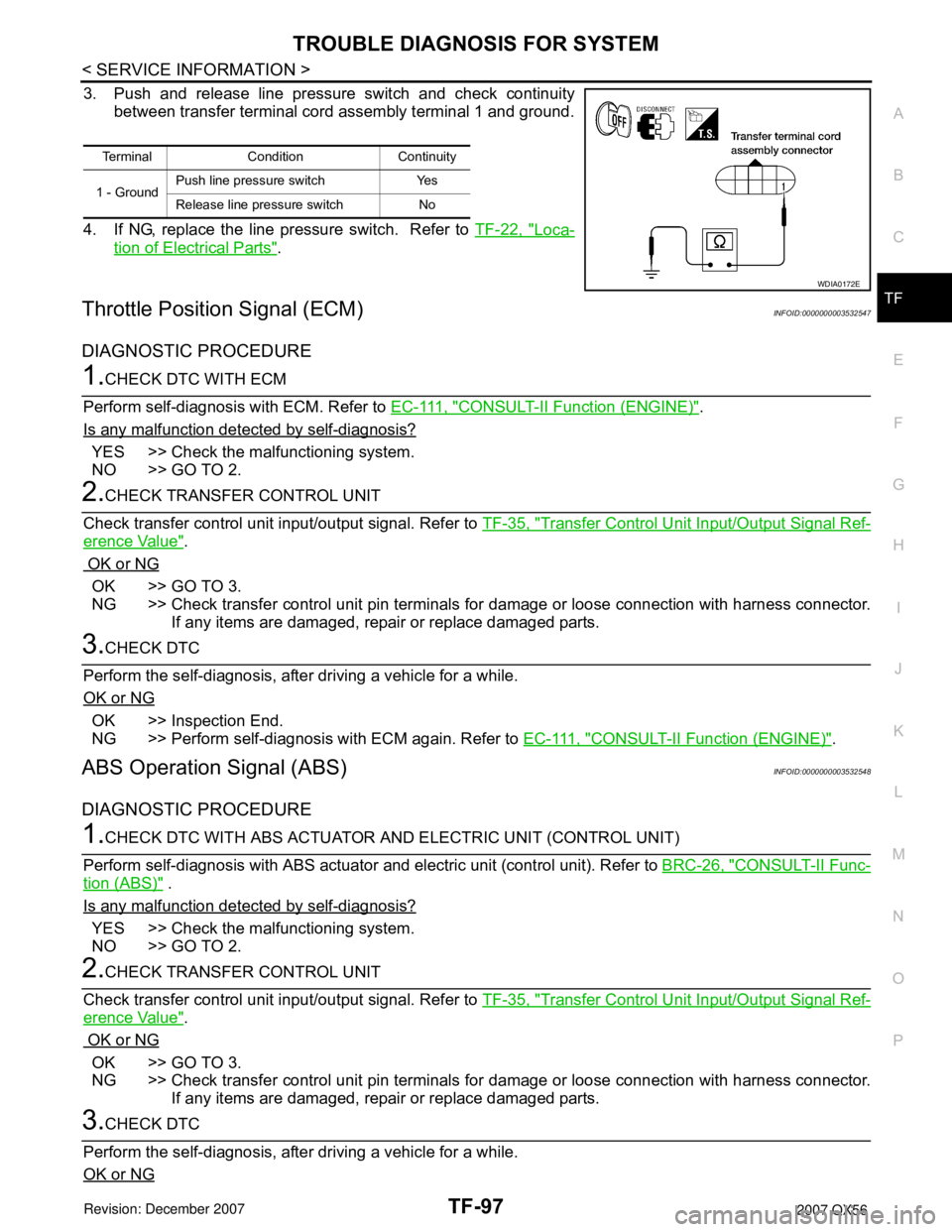
TROUBLE DIAGNOSIS FOR SYSTEM
TF-97
< SERVICE INFORMATION >
C
E
F
G
H
I
J
K
L
MA
B
TF
N
O
P
3. Push and release line pressure switch and check continuity
between transfer terminal cord assembly terminal 1 and ground.
4. If NG, replace the line pressure switch. Refer to TF-22, "
Loca-
tion of Electrical Parts".
Throttle Position Signal (ECM)INFOID:0000000003532547
DIAGNOSTIC PROCEDURE
1.CHECK DTC WITH ECM
Perform self-diagnosis with ECM. Refer to E C - 111 , "
CONSULT-II Function (ENGINE)".
Is any malfunction detected by self-diagnosis?
YES >> Check the malfunctioning system.
NO >> GO TO 2.
2.CHECK TRANSFER CONTROL UNIT
Check transfer control unit input/output signal. Refer to TF-35, "
Transfer Control Unit Input/Output Signal Ref-
erence Value".
OK or NG
OK >> GO TO 3.
NG >> Check transfer control unit pin terminals for damage or loose connection with harness connector.
If any items are damaged, repair or replace damaged parts.
3.CHECK DTC
Perform the self-diagnosis, after driving a vehicle for a while.
OK or NG
OK >> Inspection End.
NG >> Perform self-diagnosis with ECM again. Refer to EC-111, "
CONSULT-II Function (ENGINE)".
ABS Operation Signal (ABS)INFOID:0000000003532548
DIAGNOSTIC PROCEDURE
1.CHECK DTC WITH ABS ACTUATOR AND ELECTRIC UNIT (CONTROL UNIT)
Perform self-diagnosis with ABS actuator and electric unit (control unit). Refer to BRC-26, "
CONSULT-II Func-
tion (ABS)" .
Is any malfunction detected by self-diagnosis?
YES >> Check the malfunctioning system.
NO >> GO TO 2.
2.CHECK TRANSFER CONTROL UNIT
Check transfer control unit input/output signal. Refer to TF-35, "
Transfer Control Unit Input/Output Signal Ref-
erence Value".
OK or NG
OK >> GO TO 3.
NG >> Check transfer control unit pin terminals for damage or loose connection with harness connector.
If any items are damaged, repair or replace damaged parts.
3.CHECK DTC
Perform the self-diagnosis, after driving a vehicle for a while.
OK or NG
Terminal Condition Continuity
1 - GroundPush line pressure switch Yes
Release line pressure switch No
WDIA0172E
Page 2920 of 3061
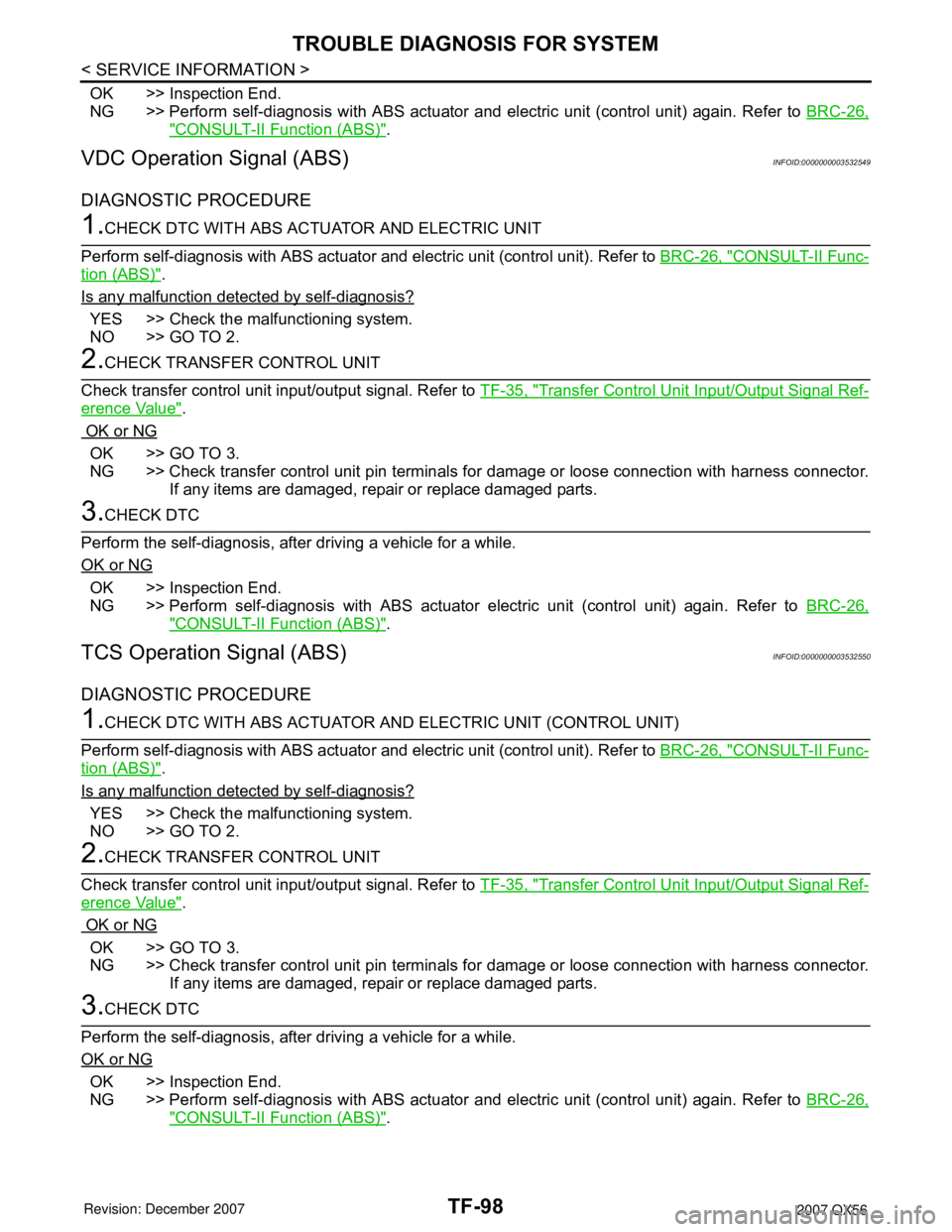
TF-98
< SERVICE INFORMATION >
TROUBLE DIAGNOSIS FOR SYSTEM
OK >> Inspection End.
NG >> Perform self-diagnosis with ABS actuator and electric unit (control unit) again. Refer to BRC-26,
"CONSULT-II Function (ABS)".
VDC Operation Signal (ABS)INFOID:0000000003532549
DIAGNOSTIC PROCEDURE
1.CHECK DTC WITH ABS ACTUATOR AND ELECTRIC UNIT
Perform self-diagnosis with ABS actuator and electric unit (control unit). Refer to BRC-26, "
CONSULT-II Func-
tion (ABS)".
Is any malfunction detected by self-diagnosis?
YES >> Check the malfunctioning system.
NO >> GO TO 2.
2.CHECK TRANSFER CONTROL UNIT
Check transfer control unit input/output signal. Refer to TF-35, "
Transfer Control Unit Input/Output Signal Ref-
erence Value".
OK or NG
OK >> GO TO 3.
NG >> Check transfer control unit pin terminals for damage or loose connection with harness connector.
If any items are damaged, repair or replace damaged parts.
3.CHECK DTC
Perform the self-diagnosis, after driving a vehicle for a while.
OK or NG
OK >> Inspection End.
NG >> Perform self-diagnosis with ABS actuator electric unit (control unit) again. Refer to BRC-26,
"CONSULT-II Function (ABS)".
TCS Operation Signal (ABS)INFOID:0000000003532550
DIAGNOSTIC PROCEDURE
1.CHECK DTC WITH ABS ACTUATOR AND ELECTRIC UNIT (CONTROL UNIT)
Perform self-diagnosis with ABS actuator and electric unit (control unit). Refer to BRC-26, "
CONSULT-II Func-
tion (ABS)".
Is any malfunction detected by self-diagnosis?
YES >> Check the malfunctioning system.
NO >> GO TO 2.
2.CHECK TRANSFER CONTROL UNIT
Check transfer control unit input/output signal. Refer to TF-35, "
Transfer Control Unit Input/Output Signal Ref-
erence Value".
OK or NG
OK >> GO TO 3.
NG >> Check transfer control unit pin terminals for damage or loose connection with harness connector.
If any items are damaged, repair or replace damaged parts.
3.CHECK DTC
Perform the self-diagnosis, after driving a vehicle for a while.
OK or NG
OK >> Inspection End.
NG >> Perform self-diagnosis with ABS actuator and electric unit (control unit) again. Refer to BRC-26,
"CONSULT-II Function (ABS)".
Page 3040 of 3061
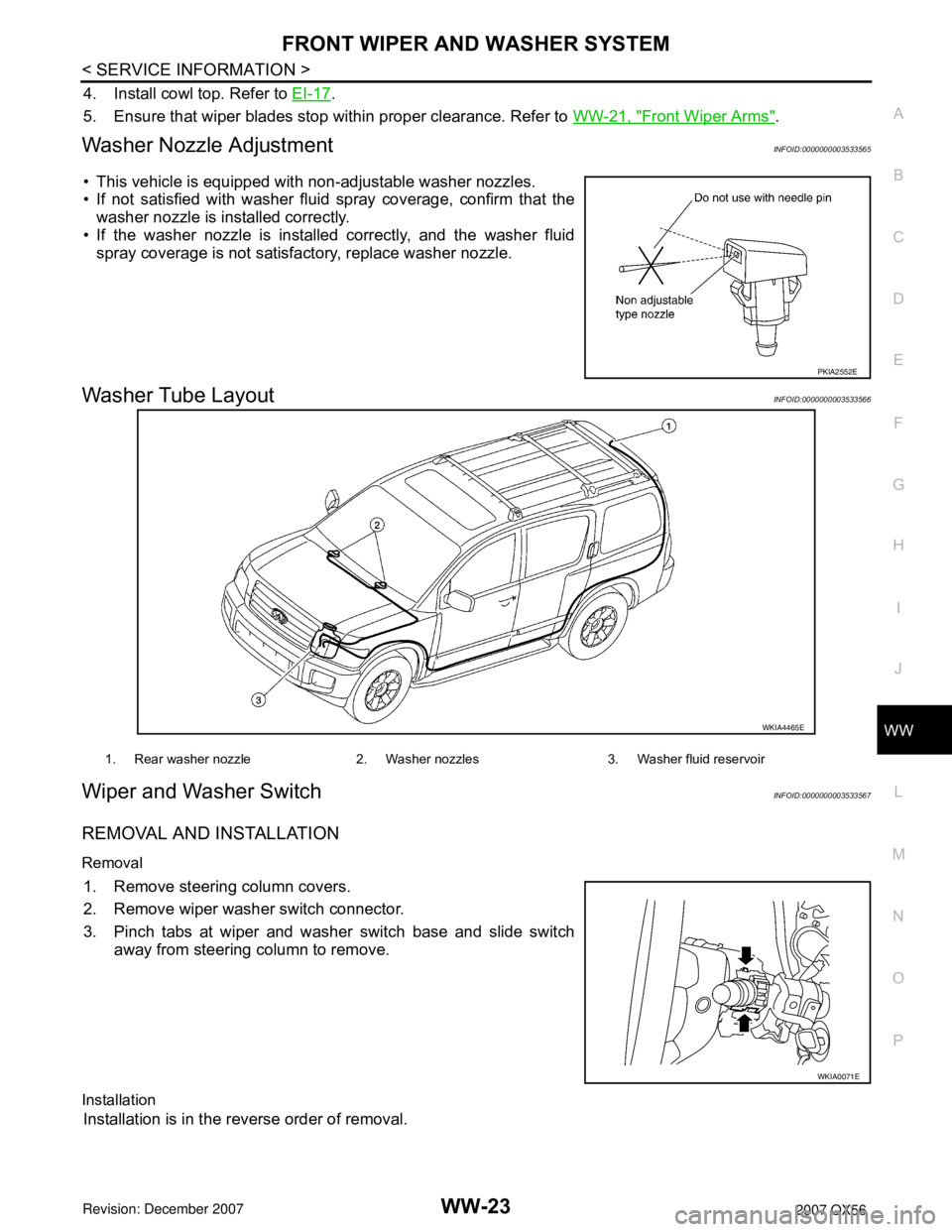
FRONT WIPER AND WASHER SYSTEM
WW-23
< SERVICE INFORMATION >
C
D
E
F
G
H
I
J
L
MA
B
WW
N
O
P
4. Install cowl top. Refer to EI-17.
5. Ensure that wiper blades stop within proper clearance. Refer to WW-21, "
Front Wiper Arms".
Washer Nozzle AdjustmentINFOID:0000000003533565
• This vehicle is equipped with non-adjustable washer nozzles.
• If not satisfied with washer fluid spray coverage, confirm that the
washer nozzle is installed correctly.
• If the washer nozzle is installed correctly, and the washer fluid
spray coverage is not satisfactory, replace washer nozzle.
Washer Tube LayoutINFOID:0000000003533566
Wiper and Washer SwitchINFOID:0000000003533567
REMOVAL AND INSTALLATION
Removal
1. Remove steering column covers.
2. Remove wiper washer switch connector.
3. Pinch tabs at wiper and washer switch base and slide switch
away from steering column to remove.
Installation
Installation is in the reverse order of removal.
PKIA2552E
WKIA4465E
1. Rear washer nozzle 2. Washer nozzles 3. Washer fluid reservoir
WKIA0071E